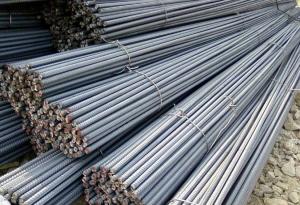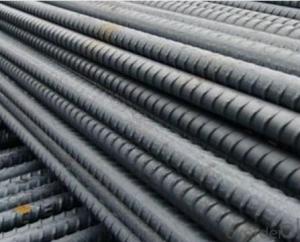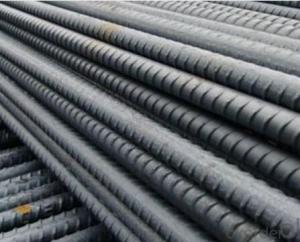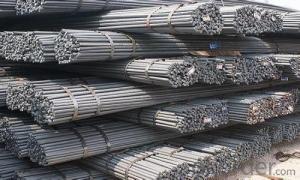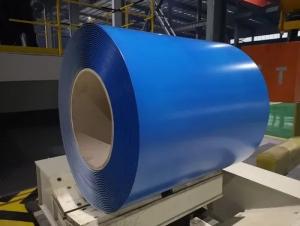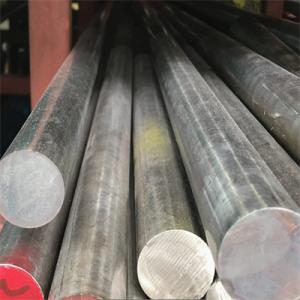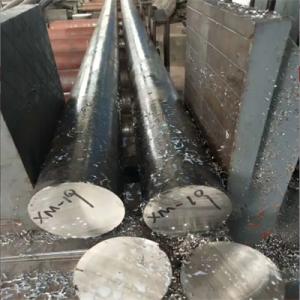Rebar Construction Deformed Bar
- Loading Port:
- China Main Port
- Payment Terms:
- TT OR LC
- Min Order Qty:
- -
- Supply Capability:
- -
OKorder Service Pledge
OKorder Financial Service
You Might Also Like
Product Description:
Specifications of HRB400 Deformed Steel Bar:
Standard | GB | HRB400 | |
Diameter | 6mm,8mm,10mm,12mm,14mm,16mm,18mm,20mm, 22mm,25mm,28mm,32mm,36mm,40mm,50mm | | |
| | |||
Length | 6M, 9M,12M or as required | | |
Place of origin | Hebei, China mainland | | |
Advantages | exact size, regular package, chemical and mechanical properties are stable. | | |
Type | Hot rolled deformed steel bar | | |
Brand name | DRAGON | | |
Chemical Composition: (Please kindly find our chemistry of our material based on HRB500 as below for your information)
Grade | Technical data of the original chemical composition (%) | ||||||
C | Mn | Si | S | P | V | ||
HRB400 | ≤0.25 | ≤1.60 | ≤0.80 | ≤0.045 | ≤0.045 | 0.04-0.12 | |
Physical capability | |||||||
Yield Strength (N/cm²) | Tensile Strength (N/cm²) | Elongation (%) | |||||
≥400 | ≥570 | ≥14 | |||||
Theoretical weight and section area of each diameter as below for your information:
Diameter(mm) | Section area (mm²) | Mass(kg/m) | Weight of 12m bar(kg) |
6 | 28.27 | 0.222 | 2.664 |
8 | 50.27 | 0.395 | 4.74 |
10 | 78.54 | 0.617 | 7.404 |
12 | 113.1 | 0.888 | 10.656 |
14 | 153.9 | 1.21 | 14.52 |
16 | 201.1 | 1.58 | 18.96 |
18 | 254.5 | 2.00 | 24 |
20 | 314.2 | 2.47 | 29.64 |
22 | 380.1 | 2.98 | 35.76 |
25 | 490.9 | 3.85 | 46.2 |
28 | 615.8 | 4.83 | 57.96 |
32 | 804.2 | 6.31 | 75.72 |
36 | 1018 | 7.99 | 98.88 |
40 | 1257 | 9.87 | 118.44 |
50 | 1964 | 15.42 | 185.04 |
Usage and Applications of HRB400 Deformed Steel Bar:
Deformed bar is widely used in buildings, bridges, roads and other engineering construction. Big to highways, railways, bridges, culverts, tunnels, public facilities such as flood control, dam, small to housing construction, beam, column, wall and the foundation of the plate, deformed bar is an integral structure material. With the development of world economy and the vigorous development of infrastructure construction, real estate, the demand for deformed bar will be larger and larger..
Packaging & Delivery of HRB400 Deformed Steel Bar:
Packaging Detail: products are packed in bundle and then shipped by container or bulk vessel, deformed bar is usually naked strapping delivery, when storing, please pay attention to moisture proof. The performance of rust will produce adverse effect.
Each bundle weight: 2-3MT, or as required
Payment term: TT or L/C
Delivery Detail: within 45 days after received advanced payment or LC.
Label: to be specified by customer, generally, each bundle has 1-2 labels
Trade terms: FOB, CFR, CIF
- Q:What is the purpose of using steel rebars in concrete structures?
- To enhance the overall strength and durability of concrete structures, steel rebars are employed. While concrete excels in compression, it lacks strength in tension. By integrating steel rebars into the concrete, the structure becomes capable of withstanding tensile forces and averting cracking or failure. Typically crafted from carbon steel, steel rebars possess robustness and high tensile strength. They are positioned within the concrete molds prior to pouring, thereby creating a reinforced concrete structure. When exposed to tensile forces, the concrete transfers the load to the steel rebars, which can effectively endure the stretching or pulling forces. This reinforcement aids in the equitable distribution of the load, warding off localized stress points and diminishing the likelihood of structural failure. In addition to providing tensile strength, steel rebars also assist in managing cracks in concrete structures. As concrete contracts and expands due to temperature fluctuations or drying, it becomes susceptible to cracking. The inclusion of steel rebars curbs the width and extent of these cracks, guaranteeing the structural integrity and prolonged lifespan of the concrete. Moreover, steel rebars heighten the resistance of concrete structures to seismic activity or other dynamic forces. The malleability of steel rebars enables them to absorb and dissipate energy during earthquakes or vibrations, thereby diminishing the risk of collapse. In essence, the purpose of incorporating steel rebars into concrete structures is to fortify and reinforce the concrete. This entails providing additional tensile strength, managing cracks, and augmenting the overall durability and resilience of the structure.
- Q:How can corrosion of steel rebars be prevented?
- Corrosion of steel rebars can be prevented through various methods such as applying protective coatings, using corrosion-resistant alloys, ensuring proper concrete cover, maintaining an effective drainage system, and implementing cathodic protection techniques. Regular inspections, proper maintenance, and prompt repairs also play a crucial role in preventing corrosion of steel rebars.
- Q:How do steel rebars affect the overall aesthetics of a building?
- Steel rebars do not have a direct impact on the overall aesthetics of a building as they are typically concealed within the concrete structure. However, their presence is crucial for structural integrity and ensuring the building's safety, which indirectly contributes to the overall aesthetics by allowing for more creative and innovative architectural designs.
- Q:Can steel rebars be used in structures with limited construction expertise?
- Steel rebars can be used in structures with limited construction expertise, but it is important to follow proper guidelines and have a basic understanding of construction principles. Rebars are commonly used to reinforce concrete structures, providing strength and durability. However, their correct placement and installation are crucial for ensuring the structural integrity of the building. While it is possible to use steel rebars without extensive construction expertise, it is highly recommended to consult with a professional engineer or a qualified construction expert for guidance. They can provide valuable insights on the appropriate placement, size, and spacing of rebars, as well as the necessary concrete mix design and curing techniques. Additionally, it is important to adhere to local building codes and regulations, as they dictate the minimum standards for structural safety. These codes often include specific requirements for the use of rebars in construction. By following these guidelines and seeking professional advice, even individuals with limited construction expertise can utilize steel rebars effectively and ensure the structural stability of their buildings.
- Q:Are there any international standards for steel rebars?
- Yes, there are international standards for steel rebars. The most widely recognized standard is the ISO 6935-2:2015, which provides specifications for steel bars used in reinforced concrete structures. Additionally, other standards like ASTM A615/A615M (USA), BS 4449 (UK), and DIN 488 (Germany) are also commonly followed for steel rebars. These international standards ensure the quality, strength, and durability of steel rebars used in construction worldwide.
- Q:Are steel rebars prone to rusting?
- Yes, steel rebars are prone to rusting. Rebars are made of carbon steel, which contains iron as its primary component. When exposed to moisture and oxygen, the iron in steel rebars undergoes a chemical reaction called oxidation, resulting in the formation of iron oxide or rust. This process can be accelerated in environments with high humidity, coastal areas with saltwater exposure, or when the rebars come into contact with water or other corrosive substances. The rusting of steel rebars can weaken their structural integrity and compromise the strength and durability of concrete structures. Therefore, it is essential to protect rebars from rust by applying anti-corrosion coatings or using stainless steel rebars in areas prone to rusting. Regular maintenance and inspection can also help identify and address any rust-related issues in a timely manner.
- Q:How many kinds of steel are needed to build the building?
- The construction steel used to construct buildings can usually be divided into steel structures, steel and reinforced concrete structures. Steel structural steel mainly consists of ordinary carbon structural steel and low alloy structural steel. It's made of steel, steel pipe and steel bar. There are angle steel, I-beam and channel steel in section steel. Reinforcing bars for reinforced concrete structures.
- Q:How are steel rebars protected against damage from chemical exposure?
- Steel rebars are protected against damage from chemical exposure through the application of protective coatings, such as epoxy or zinc coatings. These coatings act as a barrier, preventing direct contact between the steel and harmful chemicals, thereby minimizing the risk of corrosion and damage.
- Q:What is the role of steel rebars in road bridge construction?
- Steel rebars are used in road bridge construction to provide reinforcement and strength to the concrete structures. They are embedded within the concrete to help distribute and bear the load, ensuring the bridge's durability and structural integrity. The rebars help to prevent cracking and improve the overall strength of the bridge, making it capable of withstanding heavy traffic loads and adverse weather conditions.
- Q:Are steel rebars easy to handle and install on-site?
- Steel rebars are generally known for their ease of handling and installation on-site. They have widespread usage in construction projects to reinforce concrete structures like buildings, bridges, and roads. The versatility of steel rebars lies in their availability in various sizes and lengths, making them convenient to work with. They can be effortlessly cut, bent, and shaped to meet the specific requirements and design of the structure. Moreover, steel rebars are lightweight in comparison to alternative reinforcement materials, making transportation and maneuverability on-site much simpler. Additionally, their excellent tensile strength ensures both structural stability and durability. However, it is crucial to note that appropriate safety measures need to be taken while handling and installing steel rebars due to their sharpness and potential risk of injury if not managed correctly.
1. Manufacturer Overview |
|
|---|---|
| Location | |
| Year Established | |
| Annual Output Value | |
| Main Markets | |
| Company Certifications | |
2. Manufacturer Certificates |
|
|---|---|
| a) Certification Name | |
| Range | |
| Reference | |
| Validity Period | |
3. Manufacturer Capability |
|
|---|---|
| a)Trade Capacity | |
| Nearest Port | |
| Export Percentage | |
| No.of Employees in Trade Department | |
| Language Spoken: | |
| b)Factory Information | |
| Factory Size: | |
| No. of Production Lines | |
| Contract Manufacturing | |
| Product Price Range | |
Send your message to us
Rebar Construction Deformed Bar
- Loading Port:
- China Main Port
- Payment Terms:
- TT OR LC
- Min Order Qty:
- -
- Supply Capability:
- -
OKorder Service Pledge
OKorder Financial Service
Similar products
New products
Hot products
Hot Searches
Related keywords
